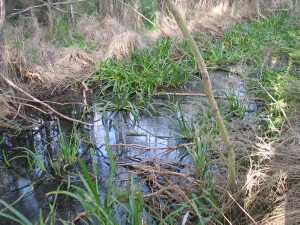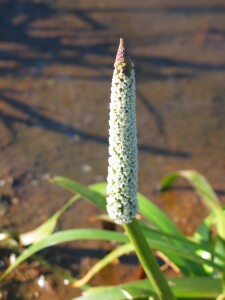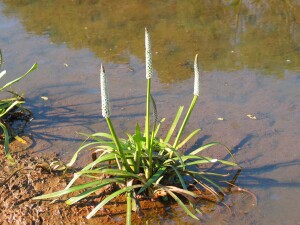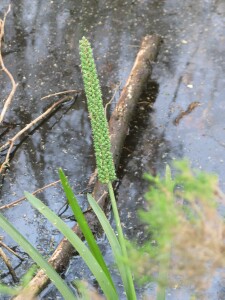Water Ribbons
Back | Salinity Indicator Plants Home | Common name home | Scientific name home | Photo Gallery | Glossary
| Water Ribbons photos | Family: Water-ribbon (Juncaginaceae) |
| Scientific Name: | Triglochin procerum |  Water Ribbons growing in acid, saline drain Photo: A J Brown | |||||
Other Common Name: | Nareli, Polango | ||||||
Status: | Native to South Australia, Queensland, New South Wales, Tasmania and Victoria. | ||||||
Plant Description: | A robust, rhizomatous, perennial, water plant. Rhizomes are 7-18 mm thick with roots ending in elongated tubers from 20-145 mm long. Leaves are flat and strap-like, 350 cm long and generally to 40 mm wide but only to 13 mm wide in East Gippsland. Flower-head is a fleshy, erect scape (stem), 27-145 cm long and 4-23 mm diameter with a spike-like flower-head (infructescence), 6-51 cm long and 17-42 mm diameter. Fruits are globular to ellipsoid in shape, 6.8-14.4 mm long. | ||||||
Habitat: | Common in still to slow-flowing fresh water of 2 m depth; permanent swamps, lagoons and streams across most of lowland Victoria, excluding the Mallee. However, it can withstand dry periods. Not normally found in saline water but see ‘Comments’ below.
| ||||||
Comments: | Normally a plant of freshwater environments, Water Ribbons displays considerable tolerance when growing in saline and acid waters in East Gippsland. This variant of the species has narrower leaves than elsewhere. Difficult to tell apart from Triglochin microtuberosum, a species confined to East Gippsland but growing in similar habitats to T. procerum. As its name implies, T. microtuberosum is distinguished by its small, nearly globular tubers, 4.5-13 mm long. |
 Flower-head (infutescence of Water Ribbons Photo: A J Brown |  Flowering plant of Water Ribbons Photo: A J Brown |
|



